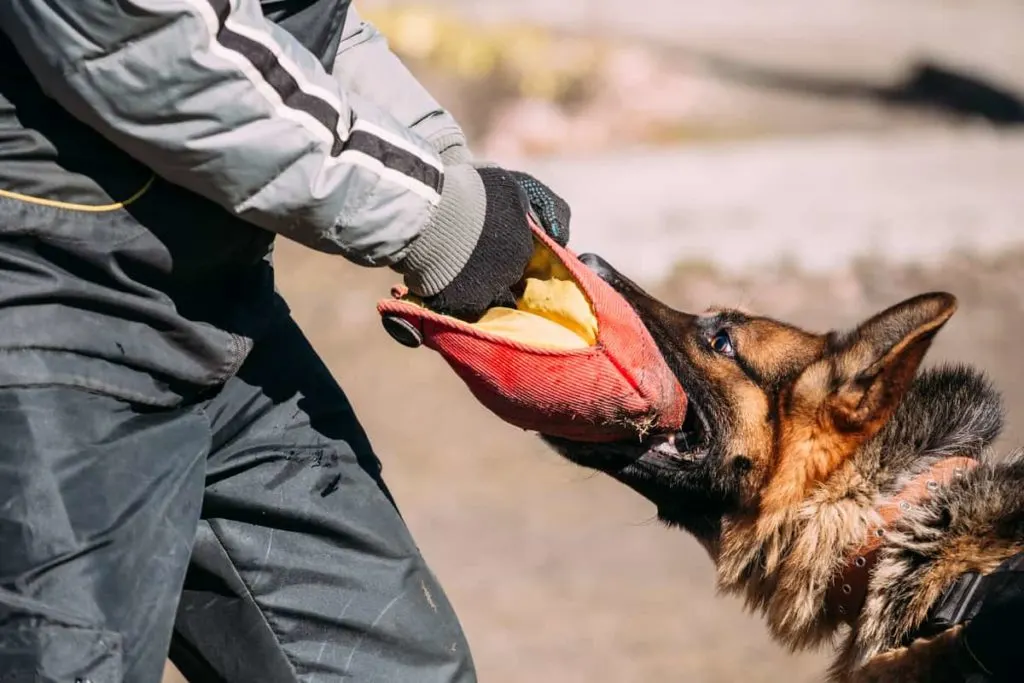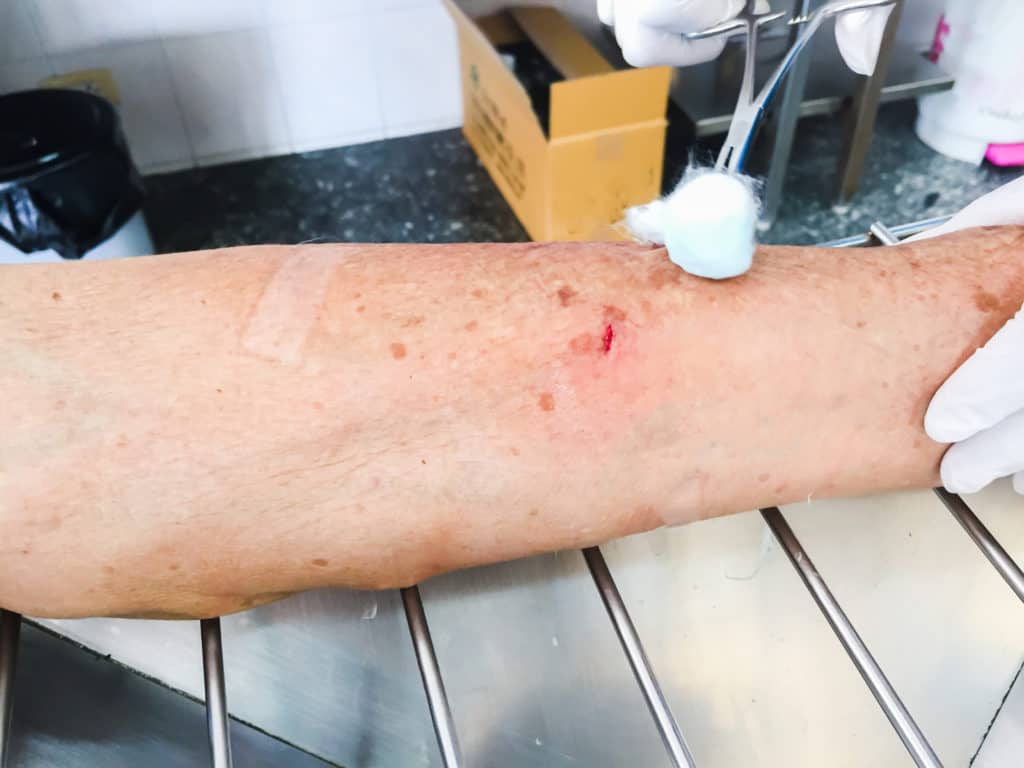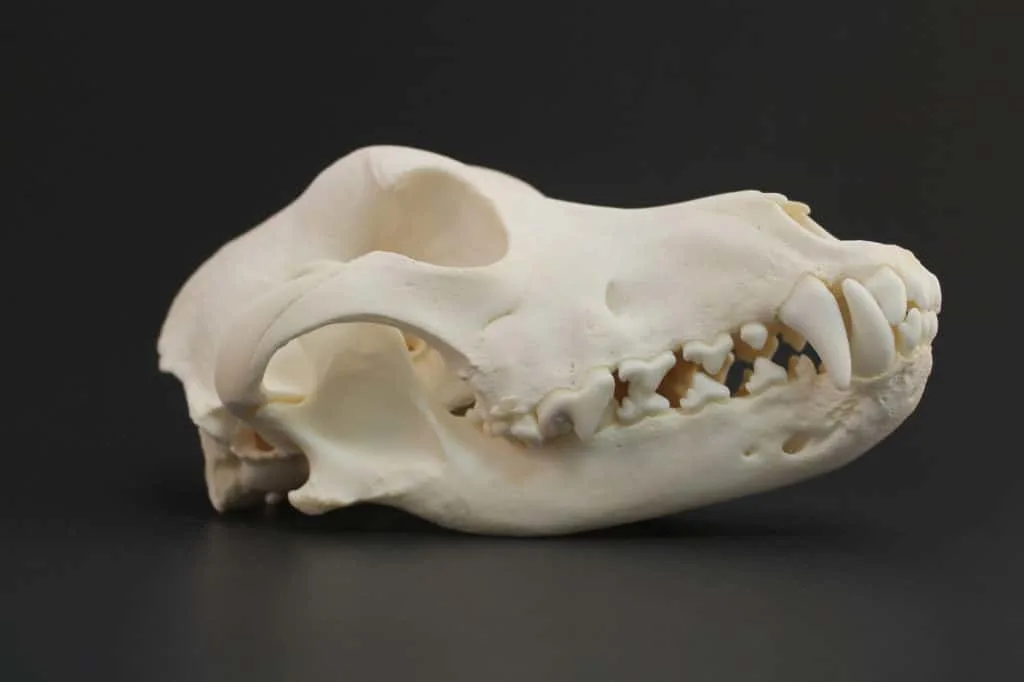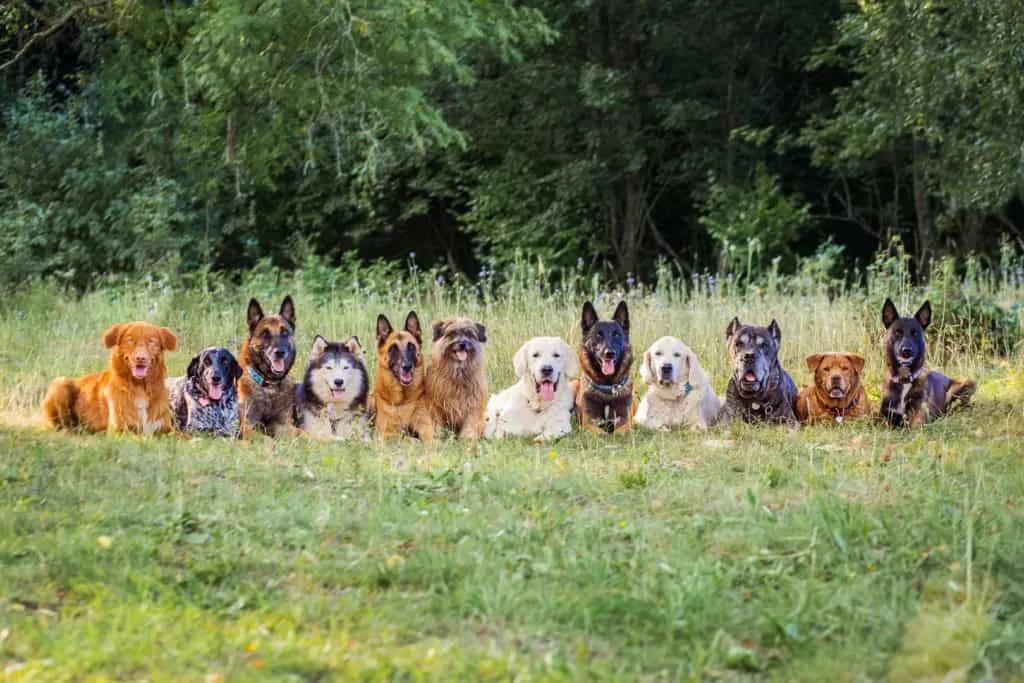
German Shepherds are widely considered as one of the best breeds for a guard dog. This is for good reason – they are fast, agile, and are capable of inflicting tremendous damage to an intruder. But exactly how powerful is the bite force of a German Shepherd?
The bite force of a German Shepherd is estimated to be 238 PSI (pounds per square inch). Though bite forces for all animals are approximate estimates since this calculation must necessarily be based on a number of different factors particular to each individual animal.
Why Does a Measuring a Dog’s Bite Force Matter?
Aside from being an interesting statistic, the measurement of a dog’s bite force is actually significant to veterinary medicine. Proper measurement of a dog’s bite force is used to determine the overall health and diagnose issues with a dog’s masticatory system.
The masticatory system is looked at as one whole unit which is composed of a dog’s teeth and its supporting structures, the jaws, as well as the joints and muscles that are involved both directly and indirectly in mastication (chewing).
In addition to this, measuring a dog’s bite force is used in veterinary medicine to develop implants such as plates and screws to fix bone fractures. It’s also used to evaluate restorative materials that must be able to withstand the extreme pressures being exerted by the dog biting down on them.
Measurement also relevant to the assessment of different dog foods, chew toys, and dental treats.
A dog’s bite force, along with the intention behind a dog’s bite also matters for purposes of public health and safety, so let’s now take a look at how the damage that a dog’s bite inflicts upon a person is used in determining exactly how dangerous a particular dog is.
Measuring the damage of a dog bite

All dogs, big or small, have the potential to bite. According to the CDC, 4.7 million people get bitten by a dog each year in the United States. Out of those, about 800,000 of them require medical care. If you take the entire population of the country into account, this means that a 1 in every 69 people are bitten by dogs annually.
While this number is very high, it does not necessarily mean that every person who gets bitten is bitten by a dangerous dog. The motivations behind why a dog may bite someone vary far and wide.
Often times a dog that is completely non-aggressive may bite someone because it was surprised or perhaps unintentionally touched on a wounded or sensitive area of its body. This type of bite is simply a reaction, and not an aggressive behavior on the dog’s part.
Evaluating this is done in a somewhat unusual way. A traditional method of measuring the intensity of a dog bite is similar to the scale used to measure the ferocity of a tornado. The measurement is not based on any specific numbers, but instead, it is based on the amount of damage inflicted.
A commonly accepted scale of assessing how severe a dog’s biting problem is dog was developed by Dr. Ian Dunbar, a Veterinary Behaviorist. It is based on the pathology of the wound inflicted by the bite, and is used to evaluate the severity of a given dog’s biting problems.
Once the wounds have been evaluated and categorized according to Dr. Dunbar’s scale, it can then be determined how likely it is that the dog’s biting problem can be corrected.

Level 1
The dog displays “obnoxious or aggressive” behavior, but makes no actual skin contact with its teeth.
Level 2
Skin contact is made by the dog’s teeth, but there is no punctured skin. Scrapes and nicks are included here provided that they are less than 1/10 of an inch deep. There may also be slight bleeding but only from a side to side movement of the dogs head – vertical punctures are not included.
Level 3
Here there will be anywhere between one to four punctures from a single bite. No puncture will be deeper than 1/2 the length of the dog’s canines. There may be lacerations from one single direction, but they must be caused by either the victim pulling their hand away, the owner pulling their dog away, or simply gravity in the case of a small dog jumping up to bite and then falling away.
Level 4
A Level 4 bite will again have anywhere between one to four punctures from a single bite, but at least one puncture will be deeper than half of the length of the dog’s canines. The person may also show deep bruising around the wound area (indicating that the dog held on and exerted pressure), or there may also be lacerations in both directions (indicating that the dog intended to have a strong grip and was shaking its head from side to side).
Level 5
This is much more severe than the previous levels. It is indicated by multiple bites with at least two of them being at a Level 4, or it may be a multiple attack scenario with at least one Level 4 bite in each one.
Level 6
A Level 6 dog bite incident is fatal to the victim.
Since GSDs are widely recognized as an “aggressive breed” and are a staple on dangerous dog breed lists, understanding the reasons behind a GSD biting someone can be the difference between life or euthanasia for the dog.
What Does This Mean for the Dog?
Once it is determined exactly where a dog’s bite falls on Dr. Dunbar’s scale, it can then be assessed how good of a candidate the dog is for rehabilitation.
Here is a breakdown of how the scale is applied:
- The vast majority of dog bite incidents fall within Levels 1 and 2. A dog that fits within these levels is not considered dangerous. Instead the dog is most likely to be out of control or fearful of something, or it may just have an unruly attitude in general.It is highly likely that the dog’s biting issues can be resolved with the implementation of basic training.
- If a dog’s bite is classified as a Level 3, the owner of the dog must be devoted to implementing consistent bite-inhibition exercises if the dog’s behavior is to be corrected.
- At level 4, this is considered a very dangerous dog. It’s unlikely that the dog’s behavior can be corrected. Here it is considered a given that the dog will bite again, and should be confined to inside the house only. Any outside visits, to the veterinarian for example, will require that the dog be muzzled. The dog’s behavior should also be reported to police and/or animal control.
- A dog whose bites are classified in Levels 5 or 6 are considered beyond rehabilitation. They are deemed to be extremely dangerous and euthanization is recommended, as the dog will otherwise essentially have to live out its days in solitary confinement.
How Is Bite Force Measured?
The unit used to measure the bite force in a dog is PSI. PSI is a unit of pressure that stands for “pounds per square inch.” You have likely heard of it as it related to the inflation of a car or bike tire. It is a measurement specifically of how many pounds of weight are being exerted on one square inch of a given object.
Dry Skull Measurements

One way to measure bite force in a dog is to use dry skull measurements. But this type of measurement lacks the conscious intention behind a living dog’s bite. The force of the bite will be dependent on the motivation of the dog behind it. With a dry skull, there is obviously no way to factor this into the measurement.
Generally speaking, the bite force estimated from a dry skull measurement will be less than that taken from a living dog. Because the dog is not living, assumptions have to be made as to the size of the dog’s facial muscles, therefore leading results to be more of an approximation rather than a specific number.
Electronic Transducer Rolled in Rawhide
This method involves the use of a hollow steel rod with a gauge on it that measures strain or pressure. It is covered by a steel strip that is rolled in rubber to protect it. The last layer is covered with a meat-flavored rawhide to appeal to a dog’s taste and encourage it to bite down on the transducer. The dog chews on the rawhide and pressure readings are obtained.
However, this method produces mixed results. This is because it is not possible to force a dog to chew something deliberately or to exert a maximum amount of force on a particular side of its mouth.
Electronic Stimulation of a Dog’s Muscles While It Is Under General Anesthesia
In order to measure a dog’s bite force using this method, a dog is first put under a general anesthetic. After the dog is anesthetized silver electrodes are implanted into a dog’s masseter muscles.
A dog’s masseter muscles connect its lower jawbone to its cheekbone, and they play a primary role in the dog’s chewing of solid foods.
Here, the dog’s masseter muscles are intermittently stimulated with an electrical current, gradually increasing in intensity, with resting periods in between. However, yet again here it is difficult to ascertain a completely accurate measure of the strength behind a dog’s bite force because the dog’s conscious motivation cannot not be factored in, and overstimulation of the muscles must be avoided to ensure the dog’s safety.
What Factors Determine How Strong a Dog’s Bite Force Is?
A dog’s bite force is not a one size fits all measurement. Different factors have to be taken into account with each individual dog to obtain the most accurate results possible. These include:
- The size and shape of the dog’s skull
- The dog’s body weight
- General oral or Temporomandibular pain (TMJ)
- Masticatory muscle disease
It’s also difficult to get consistent results when measuring a dog’s bite, as no two bites will be the same. A lot depends on the dog’s state of mind and its motivation to bite in the first place.
For example, even a dog that is trained to attack on command will not produce consistent results because the force behind his bite will largely depend on the circumstance he is facing.
If commanded to bite, he will follow orders, but there will be less ferocity and pressure behind the bite than if the dog felt that there was a danger present and was attacking to protect his owner or defend his home.
This can be compared to a boxer training for a fight. While training, his punches will be accurate and have a lot of force behind them, but his mindset is not focused on injuring the opponent. But when it comes time for the real fight, the boxer shifts his mentality and his punches are much more powerful because he now intends to do harm.
So How Much Bite Force Does a German Shepherd Actually Have?
Short answer: 238 lbs per square inch.
While estimates vary, the bite force of an adult German Shepherd is generally accepted to be between 220 and 250 pounds per square inch.
In the video below, a German Shepherd is cued to attack a man with a pressure measuring sleeve on his arm. As the dog leaps through the air with full force and the weight of his body behind him, his bite force is measured to be 238 lbs per square inch!
However, as previously explained, there remains some difficulty in accurately measuring the bite force in dogs. You will find that there is no shortage of estimates strewn about the internet – ranging between 200 and 2,000 lbs per square inch, but these are due to pure speculation and inaccurate ways of measurement.
So the true answer here is that there really is no clear and definitive measurement of a dog’s bite force, but we can get a good idea of how strong a German Shepherd’s bite force is through tests like the one illustrated in the above video.
How Does a German Shepherd’s Bite Stack up Against Other Dog Breeds?

Here is a list of the estimated bite force of other dog breeds measured in PSI in order of least to most bite force PSI.
| Dog Breed | Bite Force PSI |
| Belgian Malinios | 195 |
| Chow | 220 |
| Dutch Shepherd | 224 |
| Labrador | 230 |
| Pit Bull | 235 |
| Great Dane | 238 |
| German Shepherd | 238 |
| Doberman Pinscher | 245 |
| Bulldog | 305 |
| Husky | 320 |
| Rottweiller | 328 |
| Akita | 350 |
| Leonberger | 399 |
| Dogo Argentino | 500 |
| Perro de Presa Canario | 550 |
| English Mastiff | 556 |
| Tosa Inu | 556 |
| Dogue De Bordeaux | 556 |
| Cane Corso | 700 |
| American Bandogge Mastiff | 730 |
| Kangal | 734 |
How About Against Other Wild Animals?
Ever wonder just how strong a German Shepherd’s bite force is compared to other animals? Take a look over this table to give you a better perspective of just where a GSD stands in terms of bite force with the rest of the animal kingdom.
| Animal | Bite Force PSI |
| House Cat | 18 |
| Human | 162 |
| German Shepherd | 238 |
| Lion | 650 |
| Grizzly Bear | 975 |
| Spotted Hyena | 1,100 |
| Polar Bear | 1,200 |
| Gorilla | 1,300 |
| Jaguar | 1,500 |
| Hippopotamus | 1,800 |
| Saltwater Crocodile | 3,700 |
| Great White Shark | 4,000 |
While a German Shepherd’s bite force pales in comparison to many other inhabitants of the animal kingdom, remember that an animal’s bite force is relative to what it needs to use it for.
For example, a Polar Bear’s impressive bite force is needed to capture and kill larger prey like seals and walruses. On the other hand, a German Shepherd needs its bite force to be sufficient to contend with animals that may be trying to harm its herd.
In the day to day life of a German Shepherd, the “animals” that may try to harm it’s herd, in the dog’s eyes, are primarily people. And 238 PSI of bite force from a GSD’s jaws is more than enough to stop any person attempting to do so.
Final Thoughts
It’s very important for any German Shepherd owner to recognize just how powerful their bite force is, and to give it the respect that it deserves. This means that GSDs need to be diligently trained and well-socialized to avoid any possibility of unintentional injury to another person or animal.
For non-German Shepherd owners, it’s also very important for your safety to be aware of just how powerful the bite of a German Shepherd can be.
Do not unnecessarily put yourself in harm’s way, and always follow these “do’s” and “don’ts” when dealing with an unfamiliar dog:
Do
- Ask the owner of a dog for their permission before reaching out to pet their dog.
- If an unfamiliar dog approaches you – stay still. Let the dog investigate.
- If a dog behaves aggressively towards you and knocks you over, lie still and curl into a ball, making sure to cover your neck and ears.
- If you see a loose dog, do not approach it. Instead, call your local animal control.
Don’t
- Walk up to an unfamiliar dog.
- Run away from a dog. Their prey drive instinct may well take over and cause them to chase you.
- Panic. Make sure to stay calm and move slowly.
- Interfere with a dog while it is eating, sleeping, or tending to puppies.
- Pet a dog without first letting it sniff you.
- Allow small children to play with any dog while unattended.
